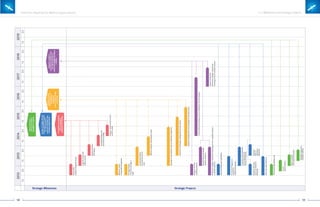The document presents a roadmap for developing Mexico's space industry. It provides background on the creation of the Mexican Space Agency (AEM) to coordinate Mexico's space activities. The roadmap was developed through workshops with representatives from academia, industry, and government. It identifies 4 key space technologies: modeling and simulation, materials and structures, communications and navigation, and scientific instruments. The document also reviews the global space economy, which totals $289 billion annually and is led by commercial sales over government budgets. The largest segment is commercial space products and services at $110 billion, including satellite communications, television, and Earth observation.
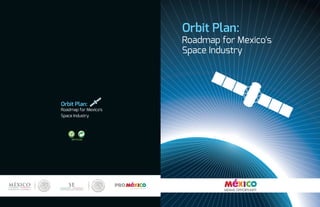





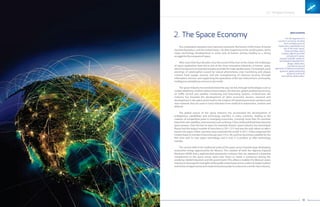



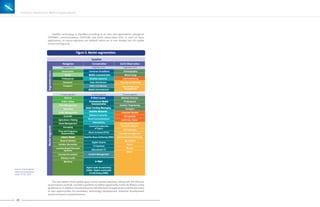


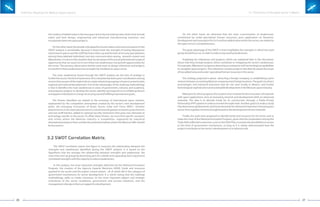




![3736
Project 1.2: Studying the of current international
regulations, including standardization and
certification by the leading space agencies
[Execution time: 12 months]
Deliverable: 1.2 Comparative study of current international standards
(Technical report)
Project 1.3:Studying the potential market (national and
international) with the companies to be
integrated or developed in the country, in order
to establish a business and financing model that
profitably maintains the establishment of the
lab network
[Execution time: 12 months]
Deliverable 1.3: Market study and business model (Technical report)
Project 1.4: Selection of minimum standards and their
potential integration in Mexico
[Execution time: 6 months]
Deliverable 1.4: Technical report and standards project
Project 1.5: Development of laboratory standardization
and accreditation bodies
[Execution time: 24 months]
Goal and description: To define standards applicable to in the development of space
products.
Currently there are several standards to be met in space product development.
However, there are no general international regulations for space technology. In addition,
although there are international initiatives related to nano satellites, like CubeSat, there is
noequivalentmodelforothertypesofspacecraft.
To facilitate the development and execution of missions in which national institutions
participate,itisnecessarytodevelopaworkplanthatrationalizestestsandrequirements.
Support and benefits:To establish an international standard framework that enables
Mexico to select and implement better practices in standardization and certification of
producttestsandtechnologydevelopment.
Goal and description: To create a group that studies the standard frameworks of the
world's leading space agencies, identifying, customizing, adapting and adopting those
minimum standards that are aligned with national projects to develop materials, products
andsoftware,amongothers,forwhichaglobalpotentialwaspreviouslydetermined.
The standards identified will be the frame of reference for research, development and
technological innovation in materials, products and software which contain a certain
degreeofnationalcomponent.
The project also covers the development of Mexican standards which serve as
referenceforthemanyspaceagencies,inareaswhereMexico'spotentialwasdetected.The
goal is to develop the standardization, testing and certification infrastructure for
businesses united in a triple helix to develop the materials, products and software, among
others, for which Mexico has potential. In addition, the project will lead to the creation of a
world-classtestingandcertificationindustrycapableofexportingthesekindsofservices.
Support and benefits: The development and establishment of a standard framework
and the related testing and certification infrastructure, will benefit the development of
high-levelhumanresourcesandthenationalspaceindustry.
Goalanddescription:TodefineastrategytopromotetheMexicanspaceindustry.The
project requires a study of the state-of-the-art and technological trends of the space
industry. This will help to determine promotion strategies for the country and make them
compatible with the business model of companies that are created or brought in to
develop tests and certifications for space components. Following the plan to penetrate
national and international markets, promotion, conversion, introduction and test
development models will be established, as well as the market for testing and
standardizationservices.
Supportandbenefits:Thisactivitywillprovideanoverviewofthedevelopmentofthe
Mexican space industry, and establish the guide for a series of actions related to human
resources, laboratories, linking, regulations, financing and establishment of business
opportunities.
Goal and description: To develop and establish a standardization body and a
framework to accredit testing labs and certification bodies that are part of the National
Center for High Technology Certification and Standardization. The creation of the
standardizationbodyandtheaccreditationframeworkcanbecompletedbasedontheLey
FederalsobreMetrologíayNormalización(LFMN).
Normalización y Certificación Electrónica (NYCE) heads this project, offering its
expertise and facilities to set up one or more working groups, in areas where Mexico is
potentiallycompetitive.
The offer can be complemented by institutions such as the Centro Nacional de
Metrología (CENAM) and other bodies that join the effort to establish a networking
framework.
Support and benefits: To create labs that can service the industry and the scientific
andtechnologicaldevelopmentgroup.
Orbit Plan: Roadmap for Mexico's Space Industry 4 / / Milestones and strategic projects](https://image.slidesharecdn.com/plandeorbita2013-ingles-130502132449-phpapp01/85/Plan-de-orbita-2013-ingles-19-320.jpg)
![3938
Project 1.6: Creation or refurbishing of space services
and technology laboratories
[Execution time: 24 months]
Deliverable 1.6: Network of space technologies test laboratories (Results report)
Project 1.7: Development of projects to enable imports,
exports and technology transfer in the
space sector [Execution time: 24 months]
Deliverable 1.7: Development of space sector businesses and companies
(Technical report)
Summary of Milestone I deliverables:
1.1 Corporate strategy and legal figure report
1.2 Comparative study of current international regulations (Technical report)
1.3 Market and business model study (Technical report)
1.4 Technical report and standards project
1.5 Opening of standardization and accreditation bodies (Technical report)
1.6 Network of space technologies testing laboratories (Technical report)
1.7 Development of space sector businesses and companies (Technical report)
4.2 Milestone II:To establish a business with the technological
capacity to design and develop space projects under a Public-
Private Partnership (PPP) model, that is both the core and
interface with participants in space projects
(Date of completion: 2014)
Project 2.1: Project 2.1: Analysis of national capabilities and
opportunity niches in the space global market
[Execution time: 6 months]
Deliverable 2.1: Study of national capabilities and global niches
Deliverable 1.5: Opening of standardization and accreditation bodies
(Technical report)
Goal and description: To contribute to the development of the Mexican space sector
by operating a network of space testing and technology laboratories to perform assays,
tests and evaluations of space parts, components and systems. The project also aims to
promote the development and improvement of design and manufacturing processes of
componentsrequiredinequipment.
The laboratories will require human resources specialized in international regulations,
and the design of a development strategy for R&D+i activities supported by academic
institutionsandcollaborationnetworks,toapproachissuesthatarerelevanttothesector.
Support and benefits: Operating the laboratories will translate into supporting the
competitive improvement of businesses in the sector, obtaining international
certifications and customizations for Normas Mexicanas (NMX), implementing certified
labsandtraininghumanresources.
Goal and description: To implement projects which strengthen the use and
developmentofforeigntrade.Theprojectisnotlimitedtolaboratories;itismoreaquestion
of industrial policy in the sector where industry and government players intervene to
negotiatewithgovernmentsfromothercountriesandtradeblocs.
Support and benefits: To leverage opportunities arising from current trade
agreements, by strengthening the capacity for trade management and promotion,
technology transfer and investment attraction, as well as quality management and the
competitiveness of space products and services.This must be reflected in a better business
climateforcompaniesinthesector.
Goal and description: To perform a study to learn about the capacities of products,
humanresources,infrastructureandtechnologiesinMexico.
This project will determine the best financing method for its execution, participate in
thecallforbidstoobtaintheselectedfundand,finally,conductthestudy.
Support and benefits: The study will help identify businesses with a similar working
logic to Mexican companies, that will help articulate global value networks. It will also help
identify the needs and niches of opportunity to develop businesses, bodies and
institutions that participate as suppliers, increasing the competences of professional
trainingandparticipation.
Orbit Plan: Roadmap for Mexico's Space Industry 4 / / Milestones and strategic projects](https://image.slidesharecdn.com/plandeorbita2013-ingles-130502132449-phpapp01/85/Plan-de-orbita-2013-ingles-20-320.jpg)
![4140
Project 2.2: Legal structure and organic statute
(Anchor business)
[Execution time: 6 months]
Deliverable 2.2: Legal structure and organic statute
Project 2.3: Definition of the business plan under the PPP
pattern, including scope and dimensions, types of
investment and partnership
[Execution time: 6 months]
Deliverable 2.3: Business plan
Project 2.4: Creation of a seed company based on defined
scope
Deliverable 2.4: Constituted business and initial financing
Project 2.5: Space infrastructure project in PPP model,
leveraging the capacity to respond to or develop
technological demand for R&D+i through the design and
management of multilateral and multidisciplinary projects
[Execution time: 6 months]
Goal and description: To complete a study on the market segments and niches of
interest of space development in Mexico.To visit companies with potential and interest to
participate, or expand their participation in these segments and niches. Finally, to
complete a business plan with one, three and five-year financial projections with a
development and launch of products and services prospective for these segments and
niches.
Support and benefits: The project will help identify potential markets and the
position of endogenous companies, enabling a better selection of market niches to be
leveragedbytheMexicanspaceindustry.
Goal and description: To articulate the R&D+i chain to meet the country's needs and
leverage the capacities and niches of opportunity, develop business, bodies and
institutionsassuppliersandoutlinecompetencesforprofessionaltraininginthisactivity.
BymeasuringMexico'scapacitiesintheaerospacesector,takingintoaccountproducts,
human resources, infrastructure and technologies, we can identify strengths, needs,
market niches and opportunities, and the context in which leading companies operate.
Thus, a business model emerges with the dimensions, scope and partnership and
investment modalities that enable the formation of a business which establishes the
conditionstodevelopandmarketspaceprojectsnationallyandinternationally.
ProMéxicowillbetheentityresponsibleforpromotingthisactivityand,ledbytheAEM,
the business, possibly within a PPP, will be the basic mechanism for incorporating the
wealthofthenation'sspace-relatedR&D+i intoproductionchains.
Support and benefits: The expertise and knowledge of businesses and research
centers with capacities in terms of products, human resources, infrastructure and
technologies, as well as those with a potential in the area, supported by the AEM and
ProMéxico within the framework of the Programa Nacional de Actividades Espaciales
(PNAE).
The project will enable the discovery of the wealth of capacities (human capital, added
value, infrastructure, products and technology) applicable to the Mexican space industry,
and the identification of niches of opportunity and possible strategic partnerships that are
set up through a determined business model. It will also promote national and
Onceestablished,topresentthestudiesconductedandsignlettersofintentorgeneral
collaborationagreementswithpartiesinterestedinexploringparticipationpossibilities.
As follow-up to this project, to create an executive presentation on the business plan,
and the formation of a seed company to present to potential partners and investors for the
firstroundoffinancing.
Supportandbenefits:TheknowledgeofbusinessmodelsintheMexicanspacesector
willhelpattractbusinesses,domesticandinternational,whichsupplyhightechnology.
Description and goal: To carry out an analysis of experiences in projects and
developments with triple helix involvement, and studies on legal structures of simple
forms of trade partnerships and participation that are accepted by current regulations for
academia,industryandgovernment,withtheparticipationofpotentialplayers.
After completing this exercise, develop a proposal of PPP models, consortiums and
other combined legal structures that facilitate the entity's operation, governance and
dissolution,ifapplicable.
Support and benefits: This project's benefit lies in research through a benchmark, the
bestgroupingmodelforestablishingabusinessthatisskilledinspaceprogramsinMexico.
Goal and description: To identify and contact potential partners, domestic and
international,topresenttheprojecttocreateananchorbusinessforspacedevelopmentin
Mexico.
Orbit Plan: Roadmap for Mexico's Space Industry 4 / / Milestones and strategic projects](https://image.slidesharecdn.com/plandeorbita2013-ingles-130502132449-phpapp01/85/Plan-de-orbita-2013-ingles-21-320.jpg)
![4342
Deliverable 2.5: Space infrastructure project in PPP model
Summary of Milestone II deliverables:
2.1 Study of national capacities and global niches
2.2 Legal structure and organic statute
2.3 Business plan
2.4 Formed business and initial financing
2.5 Space infrastructure project in PPP model
4.3 Milestone III: Milestone III: Integrating a low-orbit
multifunction satellite platform with 50% of critical
technologies developed in Mexico (Execution date 2017)
Project 3.1: Creation of the group in charge of managing the
development of the multifunction satellite platform
[Execution time: 6 months]
-
The ATG will focus on:
Developing the strategic planning for the development stages of the satellite
platform.
Identifying national and international financing sources for the project's execution.
Making a preliminary diagnosis of human resources and national academic,
industrial, government and infrastructure capacities that can help develop the
stages of the satellite platform.
Proposing international cooperation agreements that foster technology transfer
to our country.
Identifying and proposing technology transfer mechanisms that facilitate the
export and import of devices created during the process.
Identifying national needs and users of the satellite platform services, to define
the scope and priorities of the services.
Handling any procedures and permit applications with national and international
institutions required to launch an object into space.
-
Deliverable 3.1: Integration of the ATG
Proyecto 3.2: Specifications and design of the multifunction
satellite platform
Mechanical structure.
Electric power system and storage.
Orientation, stabilization and control system.
Telemetry, telecommand and telecommunications system.
On board/in flight computer.
Ground station and infrastructure for satellite tracking and control.
-
international participation in the creation of offers and projects based on established
requirements, offering Mexican bodies and businesses the possibility of joining the space
sectorvaluechainsandpositioningthemselvesintheglobalmarket.
Support and benefits: The coordination of technological, financial, planning and
project execution guidelines, and the obtaining of and compliance with applicable
regulations to ensure the quality of technology, technology transfer and successful
developmentoftheproject.
Goal and description: To create the technical group for the project, formed by
scientists and technologists, who will be part of the task forces which define the technical
specifications of the multifunction LEO satellite platform, and the conceptual design of all
its modules. In addition, they will specify and design a set of strategic interest payloads to
carryoutafirstMexicansatellitemission.
Mission analysis: To create specifications for the satellite mission, considering orbit
parametersforaLEOmicro-satellite,andsubsystemmodesofoperationandusefulremote
sensingpayloadsforobservation,transmission,processingandexploitationofthesatellite
information. At the same time, launch windows must be projected based on world
availabilityofrocketsandplatforms.
Platform and subsystem design: To create specifications and the preliminary design
of the platform's subsystems, useful payloads and electromagnetic compatibility and
reliability analysis, as well as space validation and qualification procedures for the satellite
platform.Theplatformmustincludethefollowingsubsystems:
In addition, timeframes for the development and delivery of engineering and/or flight
prototypes and models for the component modules and the integrated platform must be
scheduled.
Goalanddescription:TocreateanAdministrativeTechnicalGroup(ATG)tocoordinate
activitiestodevelopamultifunctionLEOsatelliteplatformonanationallevel.
Orbit Plan: Roadmap for Mexico's Space Industry 4 / / Milestones and strategic projects](https://image.slidesharecdn.com/plandeorbita2013-ingles-130502132449-phpapp01/85/Plan-de-orbita-2013-ingles-22-320.jpg)



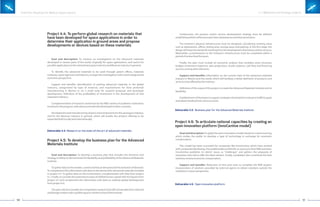
![5352
Summary of Milestone IV deliverables:
4.1 Diagnosis of advanced materials capacities
4.2 Program to support advanced materials research
4.3 Demands and investments to develop advanced materials .
4.4 Research on the state-of-the-art of advanced materials
4.5 Business plan for the Advanced Materials Institute
4.6 Open innovation platform .
4.5 Milestone V: Mexico will have a 1% share in the space
industry (one billion dollars) (Completion date: 2017)
Project 5.1: Generation and integration of a map of
transversal and complementary capacities towards
space projects
Deliverable 5.1: Map of existing transverse capacities in Mexico
Project 5.2: Creation of a space forum in Mexico
[Project leader: Eugenio García. Completion time: 2 months]
Deliverable 5.2: Report on a space industry forum
Project 5.3: Participation in international space events
Support required:
Budget to cover travel expenses, participation and related material.
Additional budget to support the industry's participation in international
space events, to capture business.
Goal and description: To identify Mexico's manufacturing capacities and existing
processes. To begin in highly integrated regions with a base of companies with certified
quality levels in their areas of competence, and which can provide certainty to space
projects. The scope of the project will include complementary survey, analysis and
territorialvocation.
To establish the bases of competition to participate in bids and/or projects, according
to manufacturing and processing capacities or, when applicable, offer the guarantee to
establish a company that sees in Mexico an already-established production value chain
thatisidealforsupplierdevelopment.
Supportandbenefits:Knowledgeofboththecurrentofferingofthespaceindustryin
Mexico and its players. Information exchange among sector players to keep them up-to-
date on their complementary universe in Mexico. Identification of competences and
capacitiestostrengthenknowledgeontheprojectsthatthecountrywillbeabletoaddress.
The content of the industry representatives survey should be designed and defined in
an accessible, friendly and easy to respond way. Bodies, chambers, institutes and similar
businesses (or that have shown interest in participating and including the industry in their
areaofinfluence)willtakepartincreatingthesurvey.Theresultsofthesurveywillprovidea
firstX-rayoftheindustrythatsupportsthespacesectorinMexico.
Goal and description: To identify or develop a space forum in Mexico. An example
might be the Sociedad Mexicana de Ciencia yTecnología Aeroespacial (SOMECYTA) forum
to be held in September 2012. This forum could be an excellent catalyst and receiver of
initiatives, projects and redefined actions for those interested in participating in the space
sector.
Support and benefits: The consolidation and institutionalization of a forum that
groupsthevariousplayers(government,educationentities,researchcentersandindustry)
to establish criteria and define actions to follow, based on complementary actions that are
takenalongtheway.
The correct promotion of this forum will attract participants who uphold the search for
solutions, inhibitors, issues, challenges and existing opportunities in the Mexican space
sector.
Goal and description: To identify one to three international space events, in order to
organizeaMexicanbusinessmissionwhichevaluatespotentialallianceswithinternational
firmsorattractiveprojectsinthesector.
To use these events to promote the AEM as a receiving agent and a promoter of space
projectsinMexico.
Support and benefits: Support from bodies, chambers, institutes and related
companiestoenrichthissurveyandprioritizethemostimportant.
Knowledge of meeting points of the space industry, events attended by decision-
makers and precision shots to space projects, considering limited economic resources for
trips abroad. The project will also allow Mexico's capacities to be promoted in the space
sector and areas where the Mexican industry can participate to become a supplier to
integratingcompanies,byorganizingworkshops.
Orbit Plan: Roadmap for Mexico's Space Industry 4 / / Milestones and strategic projects](https://image.slidesharecdn.com/plandeorbita2013-ingles-130502132449-phpapp01/85/Plan-de-orbita-2013-ingles-27-320.jpg)


